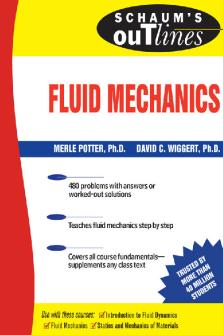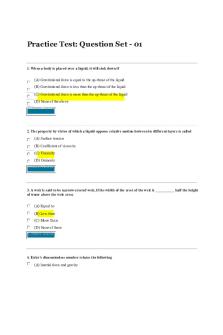fluid mechanics PDF

| Title | fluid mechanics |
|---|---|
| Author | siree mac |
| Course | Mechanical engineering |
| Institution | The Chancellor, Masters, and Scholars of the University of Cambridge |
| Pages | 8 |
| File Size | 456.4 KB |
| File Type | |
| Total Downloads | 70 |
| Total Views | 147 |
Summary
exercise with answer ...
Description
Tutorial of Fluid Statics – Chapter 3
1.
A gas is contained in a vertical, frictionless piston-cylinder device. The piston has a mass of 4 kg and a cross sectional area of 35 cm2. A compressed spring above the piston exerts a force of 60 N on the piston. If the atmospheric pressure is 95 kPa, determine the pressure inside the cylinder. [123 kPa] Fspring = 60 N
Patm = 95 kPa A = 35 cm2 m = 4 kg W
2.
The water in a tank is pressurized by air, and the pressure is measured by a multifluid manometer as shown in the figure. Determine the gage pressure of air in the tank. Take the densities of water, oil and mercury to be 1000 kg/m3, 850 kg/m3, and 13,600 kg/m3, respectively. Furthermore, h1, h2 and h3 are 0.2 m, 0.3 m and 0.46 m, respectively. [56.9 kPa] Oil
Mercury
3.
Freshwater and seawater flowing in parallel horizontal pipelines are connected to each other by a double U-tube manometer. Determine the pressure difference between two pipelines. Take the density of fresh water, seawater and mercury to be 1000 kg/m 3, 1035 kg/m3 and 13600 kg/m3, respectively. The specific gravity of oil is 0.72. Furthermore, hw, hoil, hHg,and hsea are 60 cm, 70 cm, 10 cm and 40 cm, respectively. [8.34 kPa]
Tutorial of Fluid Statics – Chapter 3
4.
The flow of water from a reservoir is controlled by 1.5 m wide L-shaped gate hinged at point A. The water height is 3.6 m. Determine (a) the resulted hydrostatic force to the gate, (b) line of action of the force, and (c) mass of the weight if we desired to open the gate. 2.4 m A
FR
5.
[(a) 95353.2 N, (b) 2.4 m, (c) 13365 kg]
B
0.9 m
3.6 m
The 280 kg and 6 m wide rectangular gate is hinged at B and leans against the floor at A making an angle of 45° from horizontal. The gate is to be opened from its lower edge by applying a normal force at its center. Determine (a) the resulted hydrostatic force to the gate, (b) line of action of the force, (c) minimum force Fm which required to open the water gate if we desired to open the gate. [(a) 499.5 kN, (b) 3.356 m, (c) 624.4 kN]
B
0.5 m
Water 3m
Fm 45°
A
6.
A 4 m long quarter-circular gate of radius 3 m and of negligible weight is hinged about its upper edge A as shown in the figure. The gate controls the flow of water over the ledge at B, where the gate is pressed by a spring. Determine (a) horizontal force on vertical surface, (b) vertical force on horizontal surface, (c) net upward vertical force, (d) the magnitude and direction of hydrostatic force acting on the gate, (e) minimum spring force required to keep the gate closed when the water level rises to A at the upper edge of the gate. [(a) 176.6 kN, (b) 353.2 kN, (c) 75.8 kN, (d) 192.2 kN with its line of action passes through the center of the gate at 23.2° upwards from the horizontal, (e) 177 kN] A
3m B Spring
Tutorial of Fluid Statics – Chapter 3
7.
In the hydraulic jack, the pistons have an area of A1 and A2 as 0.8 cm2 and 0.04 m2, respectively. Hydraulic oil is pumped in, where the small piston on the left side is pushed up and down, slowly raising the larger piston on the right side. If a car that weighs 13,000 N is to be jacked up, calculate the force F1 that is required to hold the weight of the car after the car has been lifted 2 m. The specific gravity of hydraulic oil is given as 8.70. [39.65N]
8.
The volume and the average density of an irregularly shaped body are to be determined by using a spring scale. The body weighs 7200 N in air and 4790 N in water. Determine the volume and the density of the body. [0.246 m3, 2983.5 kg/ m3]
9.
Consider a large cubic ice block floating in seawater. The specific gravities of ice and seawater are 0.92 and 1.025, respectively. If a 25 cm high portion of the ice block extends above the surface of the water, determine the height of the ice block below the surface. [2.19 m] 25 cm Sea Cubic ice block
h
Tutorial of Fluid Statics – Chapter 3
10. A water pipe is connected to a double-U manometer as shown in Fig. 1 at a location where the local atmospheric pressure is 1 atm. Determine the absolute pressure at the center of the pipe. Take the specific gravity of oil and mercury as 0.8 and 13.6, respectively. [Ans: 103512.63 Pa]
3.5 cm 6 cm
4 cm 1.5 cm
11. Consider a double-U manometer as shown in figure. Determine the absolute pressure of P 1 at a location where the barometric reading is 720 mmHg. Take the specific weight of fluid a and fluid b as 10 ×103 N/m3 and 12 ×103 N/m3, respectively. The density of mercury is given as 13600 kg/m3. [Ans: 98359.52 Pa] P1
15 cm
12 cm 5 cm
Fluid b 30 cm
Fluid a
Tutorial of Fluid Statics – Chapter 3
12. The air pressure is to be measured using a manometer whose arm is connecting pipe A and B, as shown in figure. The open arm of manometer is inclined 45° from the horizontal. The specific gravity of mercury in the manometer is 13.6. Determine the pressure difference between pipe A and B. [Ans: 75962.07 Pa] Air B
20 cm
45°
Water A 30 cm
45 cm
30 cm
MercurySG = 13.6
13. The absolute pressure of gas is measured using a manometer whose arm is connecting tank A and B, as shown in figure. The absolute pressure of gas is read as 40 kPa. The specific gravity of mercury and oil are given as 13.6 and 0.75, respectively. The local atmospheric pressure is read as 1 atm. Determine the vertical distance of h. [Ans: 11.23 m]
Water 0.2 m B Water
0.75 m 0.3 m
A
h
Tutorial of Fluid Statics – Chapter 3
14. A retaining wall against a mud slide is to be constructed by placing 1.2 m-high and 0.25 m-wide rectangular concrete blocks side by side, as shown in the figure. The friction coefficient between the ground and block is 0.4. The density of mud and block are 1400 kg/m3 and 2700 kg/m3, respectively. There is concern that the block may slide or tip over the lower left edge as the mud level rises. Determine the mud height, h as per unit length of block at which (a) block will overcome friction and start sliding and (b) block will tip over. [ (a) 0.69 m, (b) 0.75 m ]
Block Mud
h
15. A 3 m-high, 6 m-wide rectangular gate is hinged at the top edge at A and is restrained by a fixed ridge at B. Determine the hydrostatic force exerted on the gate by the water and the location of pressure center. [ 618 kN, 3.71 m]
2m Water
A Gate B
Tutorial of Fluid Statics – Chapter 3
16. A semicircular 12 m diameter tunnel is to be built under a 45 m deep, 240 m long lake, as shown in the figure. Determine the local hydrostatic force acting on the roof of the tunnel. [ 1.14×109 N ]
17. A water trough of semicircular cross section of radius 0.5 m consists of two symmetric parts hinged to each other at the bottom, as shown in the figure. The two parts are held together by a cable and turnbuckle placed every 3 m along the length of the trough. Calculate the tension in each cable when the trough is filled to the rim. [ 3678.75 N ]
1.
A 50-ton, 6 m-diameter hemispherical dome on a level surface is filled with water, as shown in below figure. Someone claims that he can lift this dome by making use of Pascal’s law by attaching a long tube to the top and filling it with water. Determine the required height of water in the tube to lift the dome. Disregard the weight of the tube and water in it. [ 0.77 m ]
Tutorial of Fluid Statics – Chapter 3
2.
The hull of a boat has a volume of 150 m3, and the total mass of the boat when empty is 8560 kg. Determine the mass of load this boat can carry without sinking (a) in a lake with density of 1000 kg/m3 and (b) in seawater with a specific gravity of 1.03. [ (a) 141440 kg, (b) 145940 kg ]
3.
The density of a liquid is to be determined by an old 1-cm-diameter cylindrical hydrometer whose division marks are completely wiped out. The hydrometer is first dropped in water, and the water level is marked. The hydrometer is then dropped into the other liquid, and it is observed that the mark for water has risen 0.5 cm above the liquid–air interface. [ 1050 kg/m3 ]...
Similar Free PDFs

Fluid Mechanics
- 260 Pages

Fluid Mechanics
- 796 Pages

Fluid Mechanics
- 8 Pages

fluid mechanics
- 8 Pages

Fluid mechanics history essay
- 16 Pages

Nestle - Summary Fluid Mechanics
- 3 Pages

Fluid Mechanics 2 MCQ
- 109 Pages

Fluid Mechanics Lab Report
- 35 Pages

Fluid Mechanics lecture notes
- 133 Pages

Introduction to Fluid Mechanics
- 321 Pages

Fluid Mechanics, Lecture 4
- 27 Pages

Fluid Mechanics - External Flow
- 7 Pages

Fluid Mechanics Cheat Sheet
- 3 Pages

Fluid Mechanics - MCQ
- 127 Pages

FLUID MECHANICS ( 2019-2020)
- 67 Pages
Popular Institutions
- Tinajero National High School - Annex
- Politeknik Caltex Riau
- Yokohama City University
- SGT University
- University of Al-Qadisiyah
- Divine Word College of Vigan
- Techniek College Rotterdam
- Universidade de Santiago
- Universiti Teknologi MARA Cawangan Johor Kampus Pasir Gudang
- Poltekkes Kemenkes Yogyakarta
- Baguio City National High School
- Colegio san marcos
- preparatoria uno
- Centro de Bachillerato Tecnológico Industrial y de Servicios No. 107
- Dalian Maritime University
- Quang Trung Secondary School
- Colegio Tecnológico en Informática
- Corporación Regional de Educación Superior
- Grupo CEDVA
- Dar Al Uloom University
- Centro de Estudios Preuniversitarios de la Universidad Nacional de Ingeniería
- 上智大学
- Aakash International School, Nuna Majara
- San Felipe Neri Catholic School
- Kang Chiao International School - New Taipei City
- Misamis Occidental National High School
- Institución Educativa Escuela Normal Juan Ladrilleros
- Kolehiyo ng Pantukan
- Batanes State College
- Instituto Continental
- Sekolah Menengah Kejuruan Kesehatan Kaltara (Tarakan)
- Colegio de La Inmaculada Concepcion - Cebu
